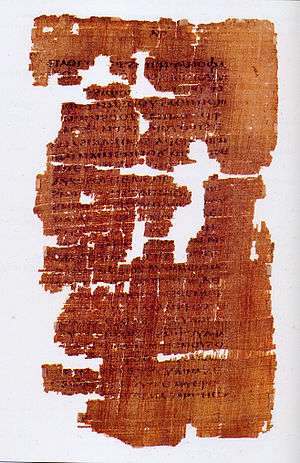Syriac Infancy Gospel
The Syriac Infancy Gospel (also known as the Arabic Infancy Gospel) is one of the texts among the New Testament apocryphal writings concerning the infancy of Jesus. It may have been compiled as early as the sixth century, and was partly based on the Infancy Gospel of Thomas, and Protevangelium of James.
Contents
It consists of three parts:
- The birth of Jesus - based on the Protevangelium of James
- Miracles during the Flight into Egypt - seemingly based on nothing more than local traditions
- The miracles of Jesus as a boy - based on the Infancy Gospel of Thomas
It contains a number of embellishments on the earlier text, however, including a diaper (of Jesus) that heals people, sweat (of Jesus) that turns into balm, curing leprosy, and dyeing cloth varied colours using only indigo dye. It also claims earlier encounters for Jesus with Judas Iscariot, and with the thieves with whom he is later crucified, as well as being one of the earliest documents.
Dating
Although this Gospel is thought to have originated from Syriac sources dating back to the fifth or sixth century,[1] it has become known to European readers by way of an Arabic version published by Henry Sike in 1697 together with a Latin translation.[2] The earliest known mention of the Gospel was by Isho'dad of Merv, a ninth-century Syrian church father, in his biblical commentary concerning the Gospel of Matthew. The narrative of the Arabic Infancy Gospel, particularly the second part concerning the miracles in Egypt, can also be found in the Qur'an. Some critical scholarship claim its presence in the Qu'ran may be due to the influence the Gospel had among the Arabs. It is not known for certain that the Gospel was present in the Hejaz, but it can be seen as likely.[3] However, according to Islamic scholars the Gospel was translated into Arabic in the post-Islamic period due the difficulty that 16th century Europeans would have in translating early Arabic's defective script into Latin as well as the extreme rarity of written texts in Pre-Islamic Arabia.[4]
Quranic parallels
One parallel story between an Infancy Gospel and the Quran is found in the Arabic Gospel Of The Infancy Of The Savior and Surah 19:29-34, where the story of Jesus speaking as a baby in the cradle in narrated.
The Arabic Gospel of the Infancy of the Savior:
v2 "He has said that Jesus spoke, and, indeed, when He was lying in His cradle said to Mary His mother: I am Jesus, the Son of God, the Logos, whom thou hast brought forth, as the Angel Gabriel announced to thee; and my Father has sent me for the salvation of the world.".
Abdullah Yusuf Ali The Quran
Surah 19:29-34
"But she pointed to the babe. They said: "How can we talk to one who is a child in the cradle?" He said: "I am indeed a servant of Allah: He hath given me revelation and made me a prophet; And He hath made me blessed wheresoever I be, and hath enjoined on me Prayer and Charity as long as I live; (He) hath made me kind to my mother, and not overbearing or miserable; So peace is on me the day I was born, the day that I die, and the day that I shall be raised up to life (again)"! Such (was) Jesus the son of Mary: (it is) a statement of truth, about which they (vainly) dispute.
In both narratives, Jesus is presented as a baby in the cradle giving a highly theological discourse in the presence of Mary about his respective mission in both religions.
See also
- Acts of the Apostles (genre)
- Agrapha
- List of Gospels
- New Testament apocrypha
- Pseudepigraphy
- Textual criticism
References
- ↑ Elliott, J.K. (1993). The Apocryphal New Testament : A Collection of Apocryphal Christian Literature in an English Translation: A Collection of Apocryphal Christian Literature in an English Translation. Oxford University Press, UK. ISBN 9780191520327.
- ↑ Henry Sike (1697). Evangelium infantiae, vel Liber apocryphus de infantia Servatoris ex manuscripto edidit, ac latina versione et notis illustravit Henricus Sike. apud Franciscum Halmam, Guiljelmum vande Water.
- ↑ The Other Bible, Willis Barnstone, HarperSanFrancisco, P.407
- ↑ "Is The Bible Really The Source Of The Qur'an?". islamic-awareness.org. Retrieved 2014-02-14.
Further reading
- New Testament Apocrypha, vol. 1, Philadelphia: Westminster Press, 1963
- Elliott, James K. The Apocryphal New Testament: A Collection of Apocryphal Christian Literature in an English Translation. Oxford: Oxford University Press, 1993.
External links
| Wikisource has original text related to this article: |
- Catholic Encyclopedia - The Arabic Gospel of the Infancy of the Saviour
- The Arabic Gospel of The Infancy of The Saviour - At Wesley center for applied theology.
- Is The Bible Really The Source Of The Qur'ân?
- The Bible Borrowing Theories Of The Qur'ân: An Authoritative Refutation
- The Apocryphal New Testament "The Arabic Infancy Gospel"
